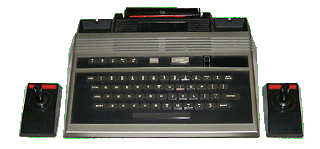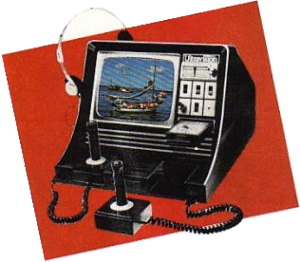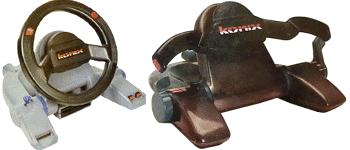The Dream Game Machines That Never Came
True
I think most of us who played videogames
had dreams about game machines that we would like to see on the market that
would blow away everything that currently existed on the market, as far as both
hardware and software are concerned. My kind of dream "game machine" was
one that went by the names of FuturaVision and MyPerCade (the latter being an
amalgamation of "my personal arcade"). It would be a rather boxy-looking
system about the same size as a ColecoVision; it would have controllers that are
sort of a mix between the ColecoVision's and the Atari 5200's (eight-way
self-centering joystick, four action buttons, a 12-function keypad, and a Reset,
a Start, and a Pause button); it would have graphics and audio capabilities
similar to those of an arcade game machine circa the early 1980s (which would
put it at the same level as a Nintendo Famicom/NES system); it would have as
part of its library ALL the popular arcade titles that would even resemble the
coin-op originals, plus a whole slew of sports titles that would made
Intellivision's sports titles look rather primitive by comparison, and some
strategy and adventure games, including a Dungeons & Dragons-type game.
Like the ColecoVision, it would also feature an expansion port that would allow
all sorts of expansion modules to be plugged in, including a laserdisk player
module for playing Dragon's Lair. I even made up some of my own
brochures for those imagined game systems like those published by various home
game manufacturers. However, by the time that Nintendo revived the dead
gaming market in America, my interest in developing a "dream game machine" had
faded to black. Other people, however, would build a different kind of
"dream game machine" in years to come, by either having an arcade game machine
run off a computer board using an emulator or by retro-fitting a computer board
of adequate size inside the casing of an old gaming console unit. Still
others would form companies to develop their own "dream game machines" for the
purpose of competing with whatever game systems are out there in the market —
but for some reason or another, most of these "dream game machine" plans would never be
fulfilled. Here are a few examples of these machines that came along over
the years:
Mattel Intellivision III and Intellivision
IV -- Mattel had compacted their original
Intellivision system into the Intellivision II model by 1982 when news of the
upcoming ColecoVision and Atari 5200 systems hit home, promising better graphics
to go with better games. Basically, they wanted in on the "next generation"
system profits, so they went to work designing the "three-quel" system that
would use wireless controllers, had built-in voice synthesis technology, and
would play all existing older Intellivision cartridges. Unfortunately, when they
saw what the ColecoVision and Atari 5200 could do for game graphics, Mattel
realized its efforts would wind up making a very primitive competitor in
comparison. That idea got scrapped and the new one for the Intellivision IV, the
real competitive game system, was born. However, Mattel sold its
videogame division off to its employees who turned it into INTV Corporation, and
when the gaming market crashed in 1984, their efforts to turn the Intellivision
IV into reality also took a nosedive.
 Magnavox Odyssey 3
-- Like Mattel, Magnavox also had its eye on retaking the market from the likes
of Atari, Mattel, and the upcoming Coleco by producing their sequel system that
had dressed-up versions of existing Odyssey 2 games. But that system never got
released in America because they too realized how primitive the actual product
would be in comparison to the ColecoVision and the Atari 5200. The Odyssey 2
also became a casualty around that time. Fortunately the system was
released in Europe as the Videopac sequel system.
Magnavox Odyssey 3
-- Like Mattel, Magnavox also had its eye on retaking the market from the likes
of Atari, Mattel, and the upcoming Coleco by producing their sequel system that
had dressed-up versions of existing Odyssey 2 games. But that system never got
released in America because they too realized how primitive the actual product
would be in comparison to the ColecoVision and the Atari 5200. The Odyssey 2
also became a casualty around that time. Fortunately the system was
released in Europe as the Videopac sequel system.
 UltraVision
-- This gem of an idea for a videogame system was noble, to say the least. It
was a standard portable color television set that would also be a self-contained
game system, and it could be expanded to play games from other systems as well
as into a full-fledged personal computer. The company that promised this
system's release made bold promises in advertisements and actually started work
on it, but it never got finished because its cost wouldn't make it feasible for
the average consumer to pick up. The only thing that survived of this idea was
two finished Atari 2600 games called Condor Attack and Karate,
both of which were bottom-of-the-barrel-type quality games.
UltraVision
-- This gem of an idea for a videogame system was noble, to say the least. It
was a standard portable color television set that would also be a self-contained
game system, and it could be expanded to play games from other systems as well
as into a full-fledged personal computer. The company that promised this
system's release made bold promises in advertisements and actually started work
on it, but it never got finished because its cost wouldn't make it feasible for
the average consumer to pick up. The only thing that survived of this idea was
two finished Atari 2600 games called Condor Attack and Karate,
both of which were bottom-of-the-barrel-type quality games.
Hasbro/ISIX ControlVision ("Project
N.E.M.O") -- Tom Zito along with former Atari
founder Nolan Bushnell, who went on to found Chuck E. Cheese's Pizza Time
Theater, started this concept of a videogame system that would connect to a VCR
and use videotapes for visual imagery as well as for storing the actual game
program back in 1985. To that effect, he developed the technology called
InstaSwitch that would allow for instantaneous switching between several
seperate video tracks on a VCR tape, producing smooth on-the-fly transitions
that such "interactive movie" games would call for. Hasbro gave Tom Zito the
funding for such a system, and he formed the ISIX division to produce what was
called at the time "Project N.E.M.O", with its final name being the
ControlVision. Two games that used the InstaSwitch technology, Night Trap
(at that time called "Scene Of The Crime") and Sewer Shark, were
developed along with the system, but by 1989 the plug was pulled on the project
when Hasbro figured out how much the system would cost the average consumer when
finished. Fortunately, the two games developed for the ControlVision went on to
become the first few games released for the Sega CD in 1992 when Tom Zito formed
the new company Digital Pictures.
 Konix Multi-System
-- Here was another really innovative idea for a home system -- one that would
use 3 1/2-inch floppy disks to store its games, plus it would have a built-in
steering wheel that can be converted into a flight-controller stick and
motorcycle handlebars for certain games. As if that wasn't enough to whet the
appetites of possible buyers, the system would also have a hydraulic chair as an
accessory! Konix, a British-based hardware company, went to work on developing
the Multi-System and its accessories, promising its release in 1989 in time to
compete with the Sega Genesis and the NEC Turbo-Grafx 16. What happened along
the way? The company ran out of money before they could finish designing the
thing before it went into production, and soon found themselves scrambling to
find anyone to help pick up the tab for completing the Multi-System. Simply put,
it was a potentially good engine of a game system idea that ran out of gas!
Konix Multi-System
-- Here was another really innovative idea for a home system -- one that would
use 3 1/2-inch floppy disks to store its games, plus it would have a built-in
steering wheel that can be converted into a flight-controller stick and
motorcycle handlebars for certain games. As if that wasn't enough to whet the
appetites of possible buyers, the system would also have a hydraulic chair as an
accessory! Konix, a British-based hardware company, went to work on developing
the Multi-System and its accessories, promising its release in 1989 in time to
compete with the Sega Genesis and the NEC Turbo-Grafx 16. What happened along
the way? The company ran out of money before they could finish designing the
thing before it went into production, and soon found themselves scrambling to
find anyone to help pick up the tab for completing the Multi-System. Simply put,
it was a potentially good engine of a game system idea that ran out of gas!
 Indrema L600 Entertainment
System -- This little-known game system from this obscure company would have
entered the market in time to compete against the X-Box, the Gamecube, and the
Playstation 2 by the turn of the millennium. One of the things it would
have offered was free open-source software development for PC users using the
Linux operating system. For the consumer who cared little for programming
his or her own games, the L600 would offer web browsing, playing of various
media sources (CD, DVD, MP3), TV show recording, email access, and other
wonderful things. Unfortunately, Indrema was so busy with press releases,
they never got around to building the system, which, along with not being able
to produce enough capital to keep their company afloat, was one of the reasons
for the company's demise along with the L600 in 2001.
Indrema L600 Entertainment
System -- This little-known game system from this obscure company would have
entered the market in time to compete against the X-Box, the Gamecube, and the
Playstation 2 by the turn of the millennium. One of the things it would
have offered was free open-source software development for PC users using the
Linux operating system. For the consumer who cared little for programming
his or her own games, the L600 would offer web browsing, playing of various
media sources (CD, DVD, MP3), TV show recording, email access, and other
wonderful things. Unfortunately, Indrema was so busy with press releases,
they never got around to building the system, which, along with not being able
to produce enough capital to keep their company afloat, was one of the reasons
for the company's demise along with the L600 in 2001.
 Infinium Labs Phantom -- In 2003
Infinium Labs came forth with their innovative game system that would rely
solely upon downloaded videogame content that would, in theory, remove the need
for physical storage media such as cartridges and disks. As great as this
system sounded with all its features, most people began to suspect that this was
yet another "dream game machine" that would never see day. Now three years
later the company has decided to put the Phantom system idea on hold after
losing money trying to get the system completed.
Infinium Labs Phantom -- In 2003
Infinium Labs came forth with their innovative game system that would rely
solely upon downloaded videogame content that would, in theory, remove the need
for physical storage media such as cartridges and disks. As great as this
system sounded with all its features, most people began to suspect that this was
yet another "dream game machine" that would never see day. Now three years
later the company has decided to put the Phantom system idea on hold after
losing money trying to get the system completed.
Coleco Chameleon -- Originally called the Retro VGS, this was a crowdfunded video game system project that was aimed at bringing back the style of gaming that was prevalent from the Atari Generation to the Playstation Generation of game systems through the use of cartridges. The system would use the shell of the Atari Jaguar as its case, hopefully to attract potential customers. However, when a "prototype" of the system was shown at the American International Toy Fair in New York in February 2016, it was eventually revealed that the "prototype" was nothing more than a modified Super NES board fit inside the casing of an Atari Jaguar. Another "prototype" which was shown in a clear Atari Jaguar casing was revealed to be a video capture card instead of an actual motherboard. Support for the system eventually died off when the public caught wind of this controversy, and the Retro VGS webpage and online social media presence were shut down.
 Magnavox Odyssey 3
-- Like Mattel, Magnavox also had its eye on retaking the market from the likes
of Atari, Mattel, and the upcoming Coleco by producing their sequel system that
had dressed-up versions of existing Odyssey 2 games. But that system never got
released in America because they too realized how primitive the actual product
would be in comparison to the ColecoVision and the Atari 5200. The Odyssey 2
also became a casualty around that time. Fortunately the system was
released in Europe as the Videopac sequel system.
Magnavox Odyssey 3
-- Like Mattel, Magnavox also had its eye on retaking the market from the likes
of Atari, Mattel, and the upcoming Coleco by producing their sequel system that
had dressed-up versions of existing Odyssey 2 games. But that system never got
released in America because they too realized how primitive the actual product
would be in comparison to the ColecoVision and the Atari 5200. The Odyssey 2
also became a casualty around that time. Fortunately the system was
released in Europe as the Videopac sequel system. UltraVision
-- This gem of an idea for a videogame system was noble, to say the least. It
was a standard portable color television set that would also be a self-contained
game system, and it could be expanded to play games from other systems as well
as into a full-fledged personal computer. The company that promised this
system's release made bold promises in advertisements and actually started work
on it, but it never got finished because its cost wouldn't make it feasible for
the average consumer to pick up. The only thing that survived of this idea was
two finished Atari 2600 games called Condor Attack and Karate,
both of which were bottom-of-the-barrel-type quality games.
UltraVision
-- This gem of an idea for a videogame system was noble, to say the least. It
was a standard portable color television set that would also be a self-contained
game system, and it could be expanded to play games from other systems as well
as into a full-fledged personal computer. The company that promised this
system's release made bold promises in advertisements and actually started work
on it, but it never got finished because its cost wouldn't make it feasible for
the average consumer to pick up. The only thing that survived of this idea was
two finished Atari 2600 games called Condor Attack and Karate,
both of which were bottom-of-the-barrel-type quality games. Konix Multi-System
-- Here was another really innovative idea for a home system -- one that would
use 3 1/2-inch floppy disks to store its games, plus it would have a built-in
steering wheel that can be converted into a flight-controller stick and
motorcycle handlebars for certain games. As if that wasn't enough to whet the
appetites of possible buyers, the system would also have a hydraulic chair as an
accessory! Konix, a British-based hardware company, went to work on developing
the Multi-System and its accessories, promising its release in 1989 in time to
compete with the Sega Genesis and the NEC Turbo-Grafx 16. What happened along
the way? The company ran out of money before they could finish designing the
thing before it went into production, and soon found themselves scrambling to
find anyone to help pick up the tab for completing the Multi-System. Simply put,
it was a potentially good engine of a game system idea that ran out of gas!
Konix Multi-System
-- Here was another really innovative idea for a home system -- one that would
use 3 1/2-inch floppy disks to store its games, plus it would have a built-in
steering wheel that can be converted into a flight-controller stick and
motorcycle handlebars for certain games. As if that wasn't enough to whet the
appetites of possible buyers, the system would also have a hydraulic chair as an
accessory! Konix, a British-based hardware company, went to work on developing
the Multi-System and its accessories, promising its release in 1989 in time to
compete with the Sega Genesis and the NEC Turbo-Grafx 16. What happened along
the way? The company ran out of money before they could finish designing the
thing before it went into production, and soon found themselves scrambling to
find anyone to help pick up the tab for completing the Multi-System. Simply put,
it was a potentially good engine of a game system idea that ran out of gas! Indrema L600 Entertainment
System -- This little-known game system from this obscure company would have
entered the market in time to compete against the X-Box, the Gamecube, and the
Playstation 2 by the turn of the millennium. One of the things it would
have offered was free open-source software development for PC users using the
Linux operating system. For the consumer who cared little for programming
his or her own games, the L600 would offer web browsing, playing of various
media sources (CD, DVD, MP3), TV show recording, email access, and other
wonderful things. Unfortunately, Indrema was so busy with press releases,
they never got around to building the system, which, along with not being able
to produce enough capital to keep their company afloat, was one of the reasons
for the company's demise along with the L600 in 2001.
Indrema L600 Entertainment
System -- This little-known game system from this obscure company would have
entered the market in time to compete against the X-Box, the Gamecube, and the
Playstation 2 by the turn of the millennium. One of the things it would
have offered was free open-source software development for PC users using the
Linux operating system. For the consumer who cared little for programming
his or her own games, the L600 would offer web browsing, playing of various
media sources (CD, DVD, MP3), TV show recording, email access, and other
wonderful things. Unfortunately, Indrema was so busy with press releases,
they never got around to building the system, which, along with not being able
to produce enough capital to keep their company afloat, was one of the reasons
for the company's demise along with the L600 in 2001. Infinium Labs Phantom -- In 2003
Infinium Labs came forth with their innovative game system that would rely
solely upon downloaded videogame content that would, in theory, remove the need
for physical storage media such as cartridges and disks. As great as this
system sounded with all its features, most people began to suspect that this was
yet another "dream game machine" that would never see day. Now three years
later the company has decided to put the Phantom system idea on hold after
losing money trying to get the system completed.
Infinium Labs Phantom -- In 2003
Infinium Labs came forth with their innovative game system that would rely
solely upon downloaded videogame content that would, in theory, remove the need
for physical storage media such as cartridges and disks. As great as this
system sounded with all its features, most people began to suspect that this was
yet another "dream game machine" that would never see day. Now three years
later the company has decided to put the Phantom system idea on hold after
losing money trying to get the system completed.
